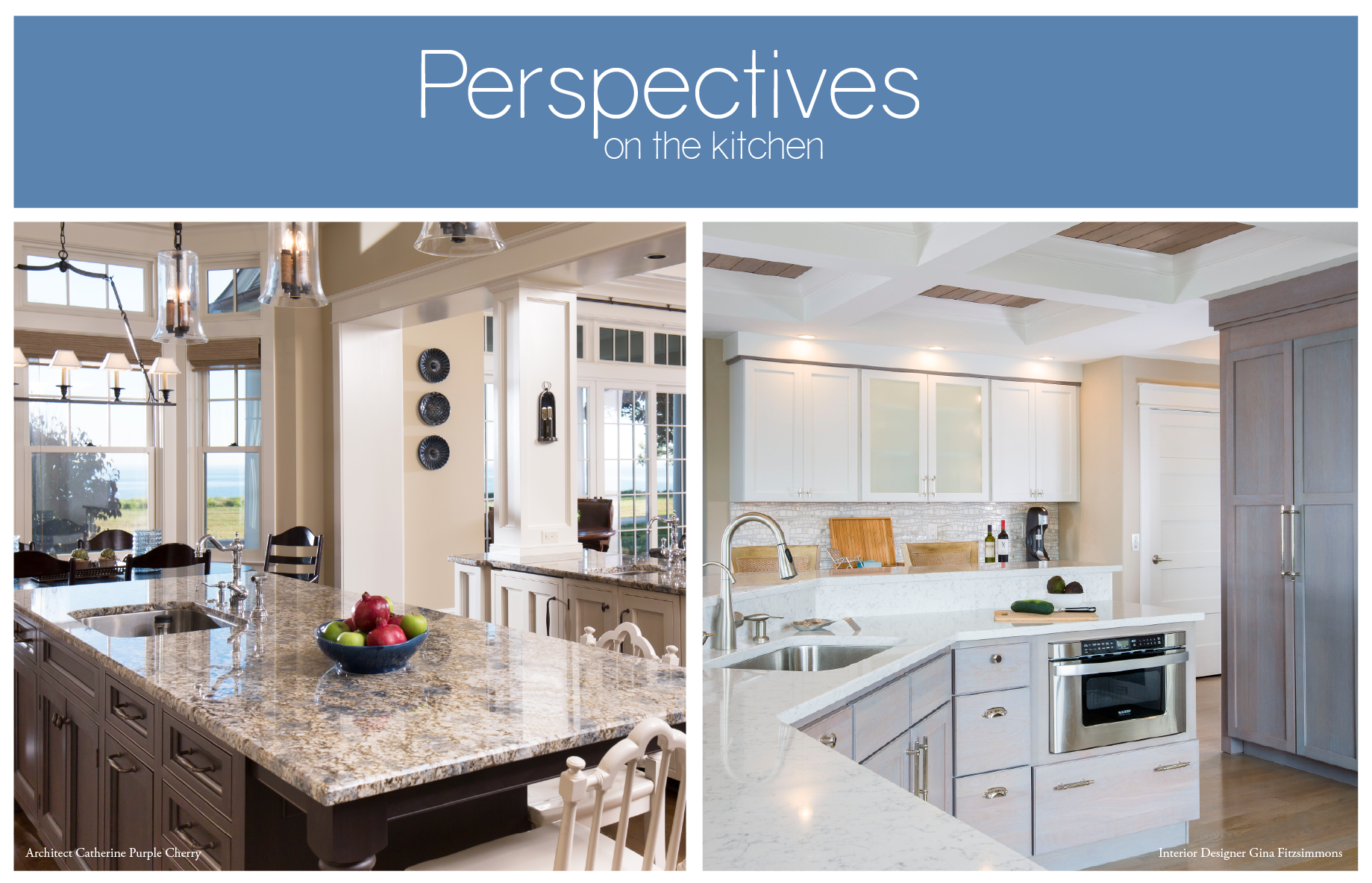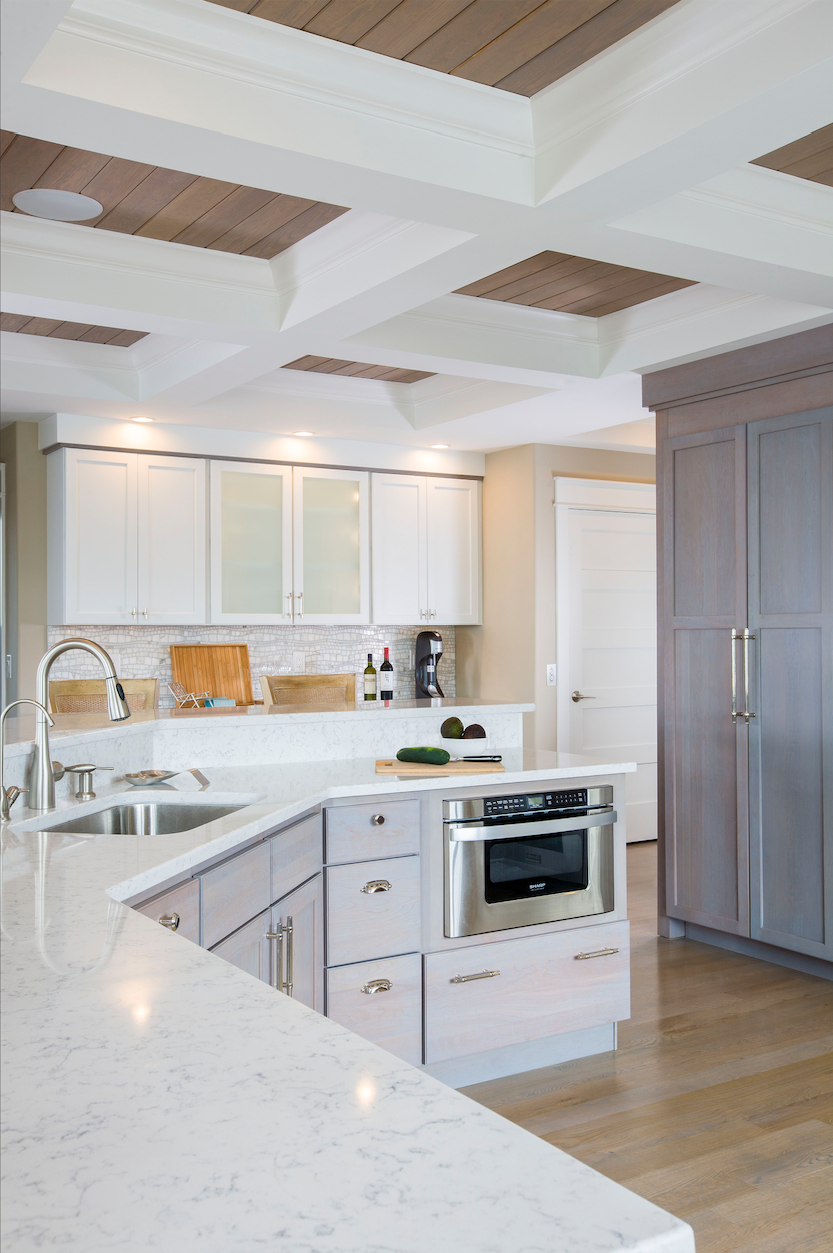- © 2025 Annapolis Home Magazine
- All Rights Reserved

In Design Talk, we ask an interior designer and an architect to address how they think about kitchen design, with a special example of their work. They have much to say. Architect Catherine Purple Cherry gives a historical overview of kitchens. She examines the evolution of the kitchen and how it changed from a functional, small room in the 1950s into a space that is now front-and-center of family gatherings. In designing a beach house, interior designer Gina Fitzsimmons discusses how good kitchen design flows seamlessly with the rest of the home, her love of details, and the power of finishes and stains to unify an environment.
For the custom home architect the kitchen is undoubtedly one of the most exciting spaces to create. It is an incredibly personal space, and to design it well requires truly understanding a client’s habits and translating them into a functional kitchen that takes
your breath away.
Over the course of the 20th century, we have witnessed a transformation of the kitchen unmatched by any other room. The way our kitchen related to the entertaining areas of the home through the mid-20th century reflects what a kitchen was originally to the family unit: a utilitarian space to prepare food. Think, for example, of the traditional 1950s household where the father worked and the mother stayed home with the children. The prevalence of households with one full-time working parent, combined with the pervasive formal dining room, resulted in minimal space requirements for the kitchen. The kitchen was essentially a one-person room. Then, through the latter part of the 20th century, we saw the inclusion of additional family members occupying the kitchen. This was due to many factors, including changes in the economy and the fact that more women were working outside of the home.
These significant changes kicked off a transformative period of house design, beginning with the opening up of the kitchen space to the family room. However, a separate dining room continued for the perceived need to showcase Grandma’s antique dining room set and to serve as a formal gathering space when hosting large groups for the holidays. By the 1980s, our families themselves were making an enormous transition to what we know as “the new normal,” a two working parents model. At the time, the kitchen had not yet evolved to support this new family dynamic, where busy schedules resulted in microwave-ready meals and chaotic countertops.
Now, welcome the 21st century where the kitchen is no longer an isolated space tucked away from view but is rather the front and center of all action. In addition to cooking, our kitchens, or more specifically, our kitchen counters, on a daily basis accommodate children’s schoolwork, adult work activities, entertaining, and casual dining. As a result, this space is larger and more open than ever before, often including one very large island or two islands. So why did the kitchen counter become the default location for such activity? Most significant was the inception of the portable laptop, which has allowed for the elimination of the home office and encouraged the migration of all related activity to the kitchen counter. In addition, the views from these new spaces are the best in the entire house. The natural light is far superior to home offices, and the working parent duo is often simultaneously supporting the other spouse or children with their efforts. Crazy schedules, the near extinction of the formal dining room, and the new dynamic of everyone wanting to be where the food and drinks are, has resulted in the kitchen becoming the space.
But cooking hasn’t been left to the wayside. It, too, has become a family affair with responsibilities for food preparation and cleanup extending beyond moms to include dads and children. In response, most new custom home kitchens are designed with a totally separate but inclusive cooking space that allows for easy sink and refrigerator access, plus a cleanup sink and two dishwashers. Further, these kitchens provide distinct beverage and snack areas with wine coolers and ice makers strategically located. And because kitchens are a major element to the design of the public areas, they are crafted in beautiful ways with granite countertops, two-tone cabinets and islands as furniture, stunning cooking stations, and incredible lighting. The 21st-century kitchen is at once the new living space, receiving the highest attention of any room in a new custom home.
Catherine Purple Cherry earned her architecture degree from the University of Maryland in 1989 and is the principal and founder of Purple Cherry Architects in Annapolis.
Credits
Architect: Catherine Purple Cherry, Purple Cherry Architects, purplecherry.com
Kitchen design: Joni Zimmerman, Design Solutions, Inc., dsikitchens.com
Interior design: Arlene Critzos, Interior Concepts, Inc., interiorconceptsinc.com
When faced with the challenge to redesign or remodel your existing kitchen, you should be excited. It is the perfect opportunity to really think it through and do it right this time under the guidance of a professional interior designer. An interior designer will help you plan your kitchen so that there is a cohesive design that flows with the rest of your house. Wall colors, cabinet finishes, countertops, backsplash, flooring, window treatments, furniture, lighting, artwork, and ceiling will all be designed as one thought for a more successful project. An interior designer helps you stand back and see the bigger picture and can help create something elusive: truly seamless living with everything working together, everything in its place, and everything in scale, balance, and proportion.
When starting this project I took into consideration that it is a beach house. My clients would spend most of their time in bathing suits, so it made sense to create a relaxed kitchen, whose main function would be to catch a quick bowl of cereal in the morning, a sandwich at lunchtime before rushing back to the beach, or hold a barbecue on the deck in the evening with neighbors and friends. The homeowners and I thought it important to have several areas for people to join in and help with composing the meal. The design includes a large island for prepping and a separate bar area for serving drinks. Silverware and plates are located close to the dining area, for easy access. Keep in mind the function of the space and make your design compatible with its usage.
 As a designer, I am always thinking, “How do I tie in the living room and dining areas of the house together architecturally?” This can be accomplished by using compatible woodworking around your fireplace wall or custom built-ins that pick up the cabinetry in the kitchen. It can also be done with the paint, finishes, hardware, or moldings.
As a designer, I am always thinking, “How do I tie in the living room and dining areas of the house together architecturally?” This can be accomplished by using compatible woodworking around your fireplace wall or custom built-ins that pick up the cabinetry in the kitchen. It can also be done with the paint, finishes, hardware, or moldings.
In this project, I designed the kitchen with a coffered ceiling with bright white beams and the same driftwood stain on the inset panels as on the great room ceiling finish. The fireplace incorporates both the bright white paint and the driftwood finish and draws the areas together visually. I used a bit of glass shelving in the kitchen to the right of the cooking hearth and again in the built-in in the great room. I also played with the combination of two finishes on the cabinetry and throughout the great room, achieving a relaxed feeling, which ties these expansive areas together.
Always remember, designers have fun with the details. You can do a backsplash with a wavy design that mimics the ocean. Here, you can see we have selected five different pieces of hardware for the cabinet doors and drawers. Mix it up, buy one of each handle or knob and see how you like them in each location. Play around with it and break the rules.
Find an interior designer with ASID (American Society of Interior Designers) and NKBA, (National Kitchen and Bath Association) following their name, and you will have a win, win situation. You will have the talents of a kitchen designer and an interior designer. Your entire home will flow together functionally and aesthetically.
Gina Fitzsimmons founded Fitzsimmons Design Associates 1991. She was trained at the Maryland Institute College of Art in Baltimore and is a professional member of the American Society of Interior Designers (ASID). She is certified by the National Council for Interior Design Qualifications (NCIDQ).
Credits
Interior and kitchen design: Gina Fitzsimmons, Fitzsimmons Design Associates,
fitzsimmonsdesign.com
From Vol. 7, No. 1 2016
Annapolis Home Magazine